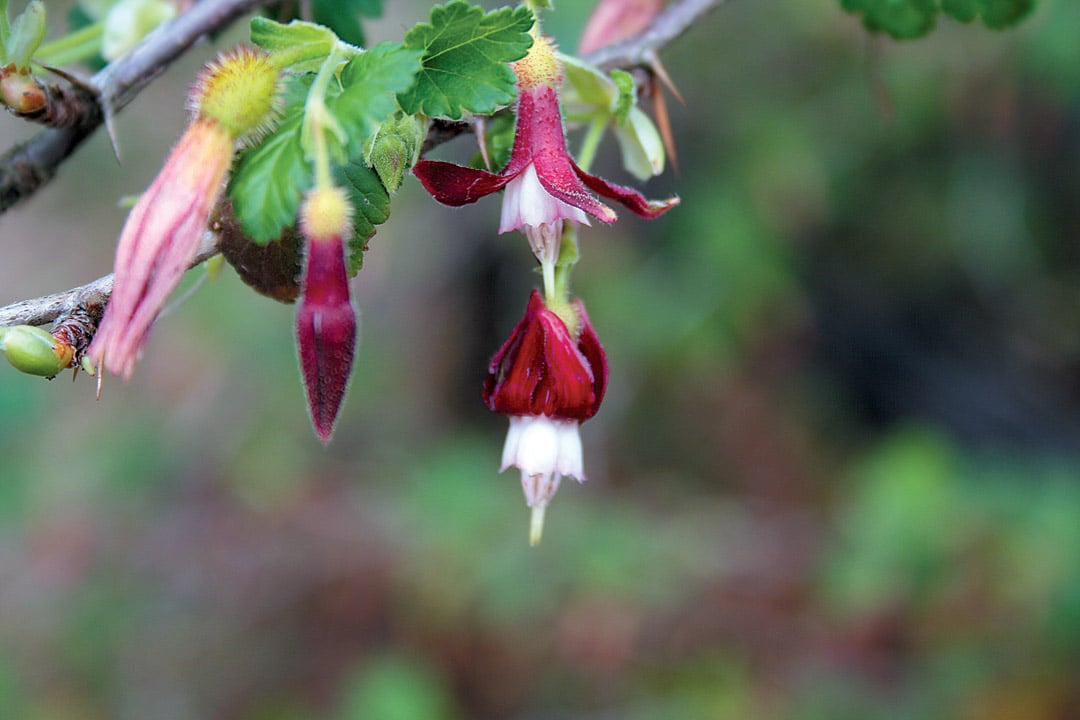
A Gooseberry Affair

Contributor

In the January 2012 issue of Pacific Horticulture, the author shared the details of his love affair with the wild currants of the West. Here, he continues with the closely related gooseberries. All of these species of Ribes warrant consideration for West Coast gardens.
If the wild currants (Ribes species) of the West, which I wrote about in the last issue of Pacific Horticulture, are uncommon in gardens, the species of Ribes known as gooseberries are virtually unknown. Only one species is occasionally seen in gardens, and usually only in those of native plant enthusiasts. The gooseberries offer a subtle beauty, albeit juxtaposed against spiny stems and fruits that can, admittedly, be off-putting. The wild currants may offer showier flowers, but the gooseberries often produce tastier fruits. Easily grown in a variety of garden situations in the West, the gooseberries deserve to be discovered.

Gooseberries have spines—often sharp and dense—on stems, leaves, sepals, and fruits. Their leaves are usually non-viscous and only occasionally aromatic. With few exceptions, goose-berries are deciduous, often dropping their leaves in response to the lack of soil moisture during the West’s long dry summers. Unlike the more upright habit of currants, gooseberries tend to be more spreading in their habit. Unless otherwise noted below: all species prefer part sun to shade, and require good drainage and little water in summer; all are hardy to at least 10°F; most grow with relative speed; all have small flowers that are attractive to hummingbirds, bees, and other insect pollinators, and have fruits that are popular with robins, mockingbirds, thrashers, grosbeaks, and other birds less likely to hang out at a feeder. [When known, Sunset climate zones are shown in brackets.]

Ribes amarum
Bitter gooseberry is a sprawling, spiny, twiggy shrub, from three to six feet tall, with a sticky, bitter fruit. Red and white flowers sparkle against shiny, dark green leaves. Native from Central California to San Diego’s higher elevations, it prefers full shade and moist soils.

Ribes californicum
This large (eight feet by six feet), refined shrub makes an excellent background plant in a bird garden, wildlife habitat, or woodland garden. Hillside gooseberry flowers abundantly with delicate red and white blossoms in February and March. Birds and bees are big fans of both flowers and fruit. Avoid planting next to walkways for its spiny stems. It is native to the Coast Ranges.
Ribes divaricatum
The thorniest of all, blackfruit gooseberry is perfectly happy as a streamside bush or moist coastal understory plant, from three to nine feet tall. Wicked spines make it an excellent burglar deterrent. Though floriferous, it is not particularly showy. It prefers shady areas and riparian corridors.
Ribes menziesii
Canyon gooseberry is a six-foot-tall, summer-deciduous,drought-tolerant shrub, with shiny green leaves on erect branches and showy maroon purple and white flowers in spring. Water conservatively, if at all, in summer. Older branches have fewer thorns, but avoid planting these shrubs near walkways. This species is native to the Coast Ranges of California and in the Sierra Nevada, north into southern Oregon.
Ribes quercetorum
Yellow or oak gooseberry is a compact shrub to three feet tall, with drooping, heavily spined branches and yellow flowers from March into May, followed by delicious red to black berries. Preferring sun to part shade in clay-based soils, it can be challenging to establish because of root sensitivity; refrain from watering after the first summer. Usually found around the drip lines of oaks in the wild, it is native to foothill slopes in the southern Coast Ranges and Sierra Nevada.
Ribes roezlii
A small, showy shrub with edible berries that make a terrific gooseberry jam, Sierra gooseberry has a tight, clean habit with fewer thorns than other species, and an eye-popping display of burgundy blossoms. Native to yellow pine forests on the western side of the Sierra Nevada and Northern California mountains, it prefers moist part shade and does well under trees or along the north wall of a house. Ribes roezlii var. cruentum ‘Dixie Glade’ is a spiny cultivar with vivid red purple and white flowers in spring.

Ribes speciosum
Perhaps the showiest of gooseberries and among the first California native plants to receive attention in the horticultural world, fuchsia-flowered gooseberry is a fast-growing, some- times evergreen shrub with abundant, apple green, slightly lobed leaves that are glossy above. In late winter and early spring, small, fuchsia-like clusters of pendant, tubular, crimson, scarlet, or pink blossoms dangle from the past year’s stems; the flowers are favored by hummingbirds over many other species because the nectar has a higher sugar content. This species is particularly drought tolerant, asking only for good drainage in a mostly sunny situation. Place this four- to six-foot-tall shrub where you can enjoy its flowers but avoid its exceedingly thorny stems. ‘Rana Creek’ is an uncommonly floriferous cultivar with bright red flowers, selected by Suzanne Schettler. [7-9,14-24]
Share:
Social Media
Garden Futurist Podcast
Most Popular
Videos
Topics
Related Posts

Ground Up Science for Greener Cities with Garden Futurist Dr. Alessandro Ossola
Spring 2023 Listen to the Podcast here. Alessandro Ossola is a scientist who gets very excited about the challenge of climate change allowing for an

Readying Urban Forests for Climate Realities with Garden Futurist Dr. Greg McPherson
Winter 2023 Listen to the Podcast here. “Going from the mow and blow to a more horticulturally knowledgeable approach to maintaining the landscape. And that

Welcome, Greywater, to the Garden
Summer 2022 Oh, summer: delightful warm air, tomatoes swelling on the vine, fragrant blooms on an evening stroll. When it’s warm and rainless, how is

Big Tree-Data and Big-Tree Data with Garden Futurist Matt Ritter
Summer 2022 Listen to the full Garden Futurist: Episode XV podcast here. We are in an environmental crisis right now in many parts of California











Responses